Rhizoctonia root rot has been reported over the past week. Rhizoctonia root rot, caused by Rhizoctonia solani, is an important soil-borne fungal pathogen with a very large host range. The pathogen can survive saprophytically on living or dead plant material (organic matter) or as sclerotia in the soil (for more than 3 years). Disease development is favored by warm temperatures, dry (or very well drained) soils and stressed plants. Symptoms of Rhizoctonia root rot may begin as stunted plant growth (with poor root systems) with the appearance of brown lesions at the base of the stem causing wilting with lesions eventually girdling the stem and killing the infected plant. Rhizoctonia root rot infections only extend about an inch above the soil surface (Figure 1), unlike Phytophthora blight infection which can extend much farther up the stem. [Read more…]
Archives for May 2025
Beech Leaf Disease Twilight Meeting June 2nd – Registration OPEN
Beech Leaf Disease Twilight Meeting
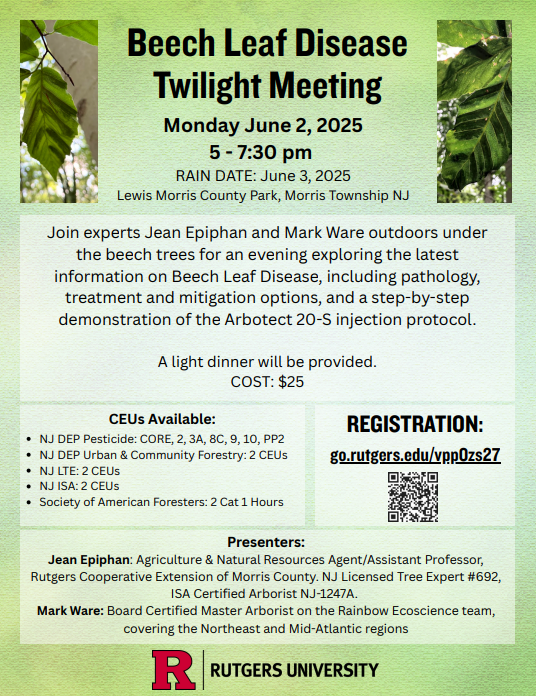
Click here to Register
- Exact address will be sent after registration
- Beech Leaf Disease Twilight – flyer
Details:
- Monday June 2, 2025
- 5 – 7:30 pm
- RAIN DATE: June 3, 2025
- Lewis Morris County Park, Morris Township NJ
- A light dinner will be provided
- COST: $25
About: Join experts Jean Epiphan and Mark Ware outdoors under the beech trees for an evening exploring the latest information on Beech Leaf Disease, including pathology, treatment and mitigation options, and a step-by-step demonstration of the Arbotect 20-S injection protocol.
Presenters:
- Jean Epiphan: Agriculture & Natural Resources Agent/Assistant Professor,
Rutgers Cooperative Extension of Morris County. NJ Licensed Tree Expert #692,
ISA Certified Arborist NJ-1247A. - Mark Ware: Board Certified Master Arborist on the Rainbow Ecoscience team,
covering the Northeast and Mid-Atlantic regions
CEUs Available:
NJ DEP Pesticide: CORE, 2, 3A, 8C, 9, 10, PP2
NJ DEP Urban & Community Forestry: 2 CEUs
NJ LTE: 2 CEUs
NJ ISA: 2 CEUs
Society of American Foresters: 2 Cat 1 Hours
Vegetable IPM update 5/22/25
Greetings from the Veg IPM team! No major changes have taken place between last week and this week, and with the continuing rainy weather, scouting has been limited.
Sweet Corn
We’ve put out corn earworm pheromone traps throughout the state. While silking corn is the main target of CEW activity, we set the traps early to detect overwintering moths. We’ve seen quite a few already, showing that some CEW moths are definitely overwintering in both North and South New Jersey. So far, we haven’t spotted any serious corn pests through visual inspection.
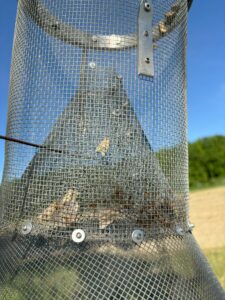
Corn earworm moths captured this week in Burlington County. Picture by Maria Cramer
Cole Crops
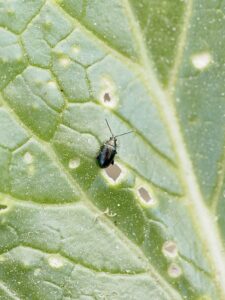
Flea beetle surrounded by feeding damage. Picture by Maria Cramer.
Flea beetle remain active in various cole crops. This year, they have been especially prevalent in lacinato kale, Napa cabbage and bok choy. Young plants are especially vulnerable to attack from flea beetles. The treatment threshold for flea beetles in heading cole crops is 50% infestation.
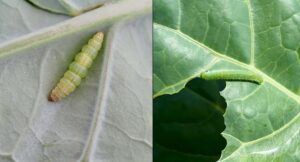
Left: Diamondback moth caterpillar, showing characteristic tapering at each end. Right: Imported cabbageworm caterpillar showing characteristic fuzziness. Pictures by Maria Cramer.
We’re seeing caterpillar activity (imported cabbageworm in the North and diamondback moth in the South) in cabbage and other cole crops. Treatment thresholds vary between crops and growth stage, but for heading cole crops between early vegetative and cupping, the treatment threshold is 30%. At this stage, sprayable Bt products (IRAC 11A) such as Dipel, Xentari, or Javelin can be effective on young imported cabbage worm caterpillars. Other materials approved for caterpillar control include Entrust/Radiant (IRAC 5), Proclaim (IRAC 6), Torac (IRAC 21A), and Exirel (IRAC 28). Diamondback moth has resistance to many insecticide groups, and pyrethroids (IRAC 3A) are not effective for their management. For Bt products and contact insecticides, coverage on the undersides the leaves is essential.
Tomatoes
In high tunnels and the first field plantings of tomatoes, we’re seeing limited aphid, thrips, and spider mite activity. If dealing with primarily aphids, products such as Beleaf (IRAC 29) are recommended, especially if plants have reached the flowering stage. We have seen aphid populations decline over the last couple of weeks without spray, probably due to lady beetle predation and parasitism from wasps. For thrips, Entrust, Radiant (IRAC 5) and Torac (IRAC 21A) can be used. For spider mites, Nealta (IRAC 25) is an effective material that is more friendly to beneficial insects, but Portal (IRAC 21A) and other materials can be used to manage populations. We’ve seen very few Colorado Potato Beetles, so while no controls are needed yet, we’ll keep an eye out for increasing populations.
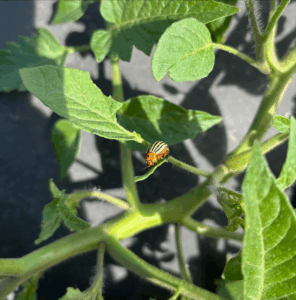
Colorado Potato Beetle adult
Beneficials
While scouting we’ve seen many beneficial insects, including predators like lacewings, lady beetles, and spined soldier bugs, as well as signs of parasitism, like aphid mummies. These natural enemies can help suppress certain pest populations. Lacewings, lady beetles, and soldier bugs feed on a wide range of soft-bodied pests, including aphids and caterpillars. Parasitoid wasps are more specialized, attacking one particular host. Basing sprays on treatment thresholds and using more selective insecticides helps preserve these natural enemies.
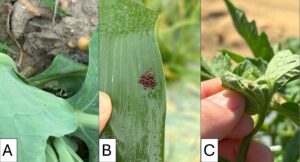
A) Green lacewing eggs on the underside of a cabbage leaf, B) Recently hatched spined soldier bug nymphs, and C) An aphid mummy. Pictures by Maria Cramer.
Please consult the Mid-Atlantic Commercial Vegetable Production Guide for a more comprehensive list of materials that are labeled for specific crops and pests. As always, be sure to follow label rates and application instructions.
Authors: Amanda Quadrel (Northern NJ Veg IPM coordinator) and Maria Cramer (Southern NJ Veg IPM coordinator)
Fruit IPM Report May 20, 2025
Peach:
Bacterial Spot: Copper formulations should be used starting at petal fall to suppress bacterial spot. Generally we recommend starting at 0.5 ozs metallic copper and gradually lowering the rate as the season progresses. The rate applied will depend on the formulation. Dr. Lalancette published a chart listing common copper formulations and rates for peach and nectarine applications. Avoid combining copper with captan especially if it has been overcast for several days. Also avoid acidic spray solutions when applying copper. Dr. Lalancette has published a handy guide for copper applications in early covers. Antibiotics containing oxytetracycline may also be used and may offer slightly more residual activity during long wetting periods. We have observed bacterial leaf spot symptoms in orchards in southern and northern counties.
Peach Scab: In addition to Rusty Spot and Bacterial Spot, Peach Scab requires protective applications starting at petal fall. Peach scab cankers (Figure 1) begin to expand at bloom and by shuck split begin to shed spores during wetting periods.
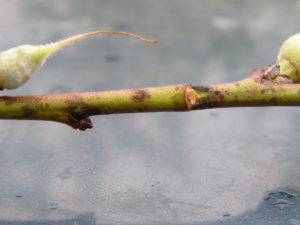
Figure 1. Peach Scab lesions on peach twig. Photo by Dave Schmitt.
Topsin, Topsin/Captan combinations, Flint Extra, Inspire Super, and Quadris Top applied at petal fall are the best materials for blocks that had scab last year. Quadris Top, Flint Extra or Topsin should be used at the high rate to suppress overwintering lesions on the wood. Quadris Top contains azoxystrobin which is phytotoxic to many apple varieties. Phytotoxic residues can remain in the tank for long periods after an application is made, even if a tank cleaner is used. Do not use Quadris Top or Abound in the same sprayer used for apples. Bravo (chlorothalonil) is also a good protectant that may be applied no later than shuck split. Captan is also helpful in cover sprays after shuck split where scab was troublesome last year.
Oriental Fruit Moth: We have recorded high OFM trap captures this season throughout the state. A biofix point for OFM was set on 4/2 for southern counties and 4/17 in northern counties. All Treatments for the first generation have past.
| OFM 2nd Generation Timing | |||
| Insecticide Type | |||
| County/Region | Degree Days by 5/19 base 45 | Conventional
1450-1500 |
Diamide
1300-1400 |
| Gloucester – Southern | 712 | 1st –too far off
2nd – too far off |
1st –too far off
2nd – too far off |
| Middlesex – Northern | 586 | 1st –too far off
2nd – too far off |
1st –too far off
2nd – too far off |
Green Peach Aphid: GPA colonies begin forming sometime during bloom. Examine trees for the presence of colonies from pink to shuck split. Count the number of colonies on ten trees and use a treatment threshold of 2 colonies/tree at petal fall for peach, and 1 colony/tree for nectarine. The best way to scout for aphids during bloom is with a beating tray. Blossoms may also be collected, opened, and examined for the presence of aphids using a hand lens. This is particularly important for nectarine blocks. Check 10 trees per block with the beating tray. Collect 50 blossoms per block and examine for the presence of aphids. If more than 1 colony of aphids are found in nectarines, or 2-3 colonies are found in peaches, an insecticide for aphids will be needed when all petals are off. See the NJ Commercial Tree Fruit Production Guide for recommended materials and rates. We are observing aphid colonies above threshold at some farm sites.
Plum Curculio; Tarnished Plant Bugs; and Other Catfacing Insects: We continue to see an increase of percent injury on fruit from plum curculio with an average 1.5% injury reported on developing apples in southern counties. Plum Curculio start to move into orchards at about 88-100 degree days base 50 after January 1. Applications for PC should be initiated once all petals are off, with a second application made with ovicidal materials at 379-402 DD. We are currently past this treatment window as southern counties have accumulated about 664 DD base 50 and northern counties have accumulated 584 DD base 50. Growers can monitor degree day development at their site by finding the nearest weather station and using the degree day development tool at NEWA. Catfacing insects are active now and can cause injury. Greater than 1 to 2% fresh catfacing injury on the fruit means that adjustments have to be made in the spray program.
Scale Insects: White peach scale crawlers will begin to emerge in southern counties and should continue emergence until about the middle of June. San Jose scale crawlers typically begin emergence about late May or Early June and continue emergence for up to 6 weeks. Control options during crawler emergence include Neonicotinoids (suppression only), and the IGR’s Esteem and Centaur. See the NJ Commercial Tree Fruit Production Guide and the product labels for more information.
Apples and Pears:
Diseases: Now that primary scab is nearing the end, or has ended, the focus turns toward summer diseases such as fruit rots (esp. Bitter rot), and sooty blotch and fly speck. Bitter rot control has been difficult at best in recent years even where management programs have been rigorous. Research has suggested products such as Merivon, Luna Sensation, Inspire Super, and Aprovia may be effective, and longtime reliable broad spectrum fungicides such as omega, captan and ziram should provide control. Experience has suggested that the addition of phosphorous acid products such as Prophyt or Rampart to captan sprays may improve control. Observations are that these products improve control of other summer diseases such as sooty blotch and flyspeck, and may help suppress scab infections where present. Scab symptoms are appearing in some orchards statewide.
Fire Blight: Infections can still occur post bloom so covers with antibiotics when infection events are forecast using the NEWA fire blight model may be beneficial. Remember to rotate streptomycin and oxytetracycline products. Where symptoms occur (Figure 2) it is recommended to cut out infected limbs; however, this is a practical decision that must be made.
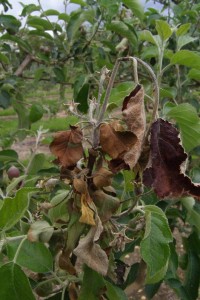
Figure 2. Fire Blight strike on limb in apple.
This blog post from Michigan State may be helpful to decide whether it is worth cutting out infected tissue. Once the terminal buds set, typically in July, infected wood should be removed to prevent colonization by the bitter rot pathogen.
Codling Moth: A Codling Moth Biofix was set in Southern counties on 4/28 and in Northern counties on 4/30. See the NJ Commercial Tree Fruit Production Guide for recommended materials and rates. Where Mating Disruption has been employed, supplemental Madex applications should be made at the timings listed below.
| Codling Moth Degree Day Timing | |||||||||
| Application and Insecticide Type | |||||||||
| County Area | Biofix | Rimon:
75-100DD + 14-17 days later
|
Intrepid
150 + 450 DD Diamides – Altacor, Voliam mixes: (150-200 DD) |
Madex
250 DD + every 7-9 days during brood hatch (later if first spray is an IGR) |
Standard Insecticides – Delegate, Avaunt, OP’s, carbamates, pyrethroids
250 DD + 550 DD
|
||||
| DD | 75 | 100 | 150 | 450 | 250 | 250 | 550 | ||
| Southern | April 28 | past | past | past | too soon to predict | past | past | too soon to predict | |
| Northern | April 30 | past | past | past | too soon to predict | past | past | too soon to predict | |
Scale Insects: Dormant oil applications are standard recommendations for scale control but in some years when conditions are not optimal for oil application scale control may be less than desired. Where oil was not applied or in orchards where scale is a recurring problem, an application of Centaur at petal fall or Movento between petal fall and first cover should “clean up” problem blocks. Centaur is recommended at 34.5 oz/A and Movento should be applied at 6-9 oz/A. A penetrant must be included to Movento as per the product label. Movento will also control apple aphids, including Wooly Aphid, when used at this timing. In pears Movento may also control aphids and 2nd generation pear psylla (if eggs are present) when applied at first cover.
Wooly Apple Aphid (WAA); Green Apple (Spirea) Aphids (GAA): GAA colonies are present in some apple blocks. GAA is generally a pest that can be tolerated since they do little direct damage. Treatment thresholds for GAA are if 50% of the shoots are infested with no beneficial insects present. WAA aerial colonies are also beginning to form in southern counties. This is about a month earlier than usual. In most years these are controlled by beneficials; however, in some years like 2022, serious outbreaks can occur. The best control for WAA is Movento applied before or when the first colonies appear. Diazinon is also effective at knocking down infestations. Movento will also control GAA and should control San Jose scale when applied in mid-May, and suppress scale when applied in late May or early June. Do not combine Diazinon with Captan.
Ambrosia Beetle : Trap captures continue to decline. Infested trees should be showing signs of stress or will be soon. Once these beetles bore into the trunk, they will form a gallery in the heartwood of the tree to lay their eggs and farm the ambrosia fungus to feed themselves and their larvae. Once the female lays her eggs, it will take about 30 days for them to become adults and emerge from their host tree to begin the second flight. If you have had a history of this pest in your orchard, you should begin scouting for damage and remove any trees that have been attacked. It may be beneficial to leave attacked trees in the orchard for a few weeks before removal so they can act as trap trees to reduce populations. Beetles generally do not leave the host tree once they’ve attacked it. They will attract other beetles to the stressed tree and adjacent trees so they tend to stay in one area rather than spread throughout the orchard.
Pear Psylla: Second generation pear psylla adults are present and laying eggs in southern counties (Figure 3).
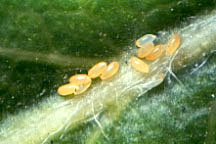
Figure 3. Pear Psylla eggs along midrib.
Hatch should begin soon. Options for control include spinosyn products such as Delegate and Entrust, and the neonicotinoids (IRAC group 4A). The addition of 0.25-1 gal of summer oil may improve control. Other options include Movento, and products containing abamectin. If you are planning to use Movento for the second generation it should be applied just before hatch or as soon as newly hatched nymphs appear as it takes about a week for the material to move throughout the tree. Be sure to read and follow the label instructions regarding the addition of penetrants for these products.
Grapes
Early blooming native grapes were at trace bloom on 5/16, therefore we have set the Grape Berry Moth (GBM) biofix at 5/16 for southern counties. Since V. riparia typically blooms with early natives we used Concord and Ives to set the biofix. The model works best when growers record their own bloom dates and use the Grape Berry Moth model at NEWA. Applications for GBM using Intrepid or Diamides should be made at 810 DD base 47 from the biofix date. Other effective materials can be applied a few days later. Applications have been historically made around the end of June in southern counties. SLF nymphs were observed emerging the week of 4/28 in southern counties and will continue to hatch over several weeks. Management for SLF nymphs is not recommended at this time. The most important diseases to manage at this time are Phomopsis, Powdery Mildew, and Black Rot. More information about early season disease control can be found in this blogpost from Virginia Tech.
Phenology Table: Based on annual observations made in Gloucester County.
| Pest Event or Growth Stage | Approximate Date | 2025 Observed Date |
| Bud Swell (Redhaven/PF-17) | March 23 +/- 15 Days | March 30 |
| 1/4″ Green Tip Red Delicious | March 31 +/- 13 Days | March 30 |
| Pink Peach (Redhaven/PF-17) | April 4 +/- 15 Days | April 1 |
| Tight Cluster Red Delicious | April 9 +/- 13 Days | April 5 |
| Full Bloom Peach (Redhaven/PF-17) | April 9 +/- 14 Days | April 10 |
| Pink Apple (Red Delicious) | April 14 +/- 12 Days | April 16 |
| Full Bloom Apple (Red Delicious) | April 22 +/- 11 Days | April 25 |
| Petal Fall (Redhaven) | April 22 +/- 10 Days | April 19 |
| Petal Fall (Red Delicious) | April 27 +/- 13 Days | May 2 |
| Shuck Split (Redhaven) | April 30 +/- 11 Days | April 26 |
| Pit Hardening | June 15 +/- 9 Days |
Tree Fruit Trap Captures – Southern Counties
| Week Ending | STLM | TABM-A | CM | BMSB | OFM-A | DWB | OFM-P | TABM-P | LPTB | PTB |
| 4/5/2025 | 0 | 0 | 0 | 0 | 0 | 0 | 0 | 0 | 0 | 0 |
| 4/12/2025 | 0 | 0 | 0 | 0 | 6 | 0 | 0 | 0 | 0 | 0 |
| 4/21/2025 | 0 | 0 | 0 | 0 | 36 | 0 | 1 | 0 | 0 | 0 |
| 4/27/2025 | 25 | 0 | 0 | 0 | 24 | 0 | 5 | 0 | 1 | 0 |
| 5/2/2025 | 517 | 0 | 4 | 0 | 12 | 0 | 6 | 0 | 13 | 0 |
| 5/9/2025 | 159 | 4 | 10 | 0 | 3 | 16 | 5 | 4 | 46 | 0 |
| 5/16/2025 | 91 | 11 | 6 | 0 | 1 | 36 | 2 | 14 | 69 | 0 |
Tree Fruit Trap Captures – Northern Counties
| Week Ending | STLM | TABM-A | CM | BMSB | OFM-A | DWB | OFM-P | TABM-P | LPTB | PTB | AMBROSIA BEETLE |
| 4/5/2025 | 387 | 0 | 0 | 0 | 0 | 0 | 0 | 0 | 0 | 0 | 0 |
| 4/21/2025 | 435 | 0 | 0 | 0 | 0 | 0 | 1.3 | 0 | 0 | 0 | 0 |
| 4/27/2025 | 26 | 0 | 0 | 0 | 0 | 0 | 25 | 0 | 0 | 0 | 72 |
| 5/2/2025 | 86 | 0 | 0.33 | 0 | 72.5 | 0 | 47.2 | 0 | 0 | 0 | 136 |
| 5/9/2025 | 56 | 0 | 5.3 | 0 | 58.8 | 0 | 22.9 | 0 | 0 | 0 | 145 |
| 5/16/2025 | 13.75 | 2.6 | 7.3 | 0 | 4 | 0 | 5 | 0 | 0 | 0 | 50.5 |
Ornamental IPM 5/13 Recording Upload – NUMEROUS PEST ALERTS
Still time to Sign up for the 2025 – Rutgers Ornamental IPM Program
(Join us for the next Session Tuesday 5/27/25)
PREVIOUS SESSION: (contains information on boxwood pests, armored scales, needlecast diseases, oomycetes )
Note we have clearwing borer lures and wing or delta traps, scale crawler tape, and yellow sticky cards available to commercial grower program members at our Cumberland (twaller@njaes.rutgers.edu) and Monmouth (william.errickson@njaes.rutgers.edu) RCE offices.
ALERTS:
- Scale crawler emergence throughout the state
- Spruce spider mite activity and damage
- Boxwood Blight Risk Model for next 7days
- Bronze Birch Borer (BBB) approaching adult emergence
- Clearwing Borer adult flight – time to monitor / treat
- Red-headed flea beetle (RHFB) egg hatch – adult emergence
- Oomycete material considerations
Previous webinars:
- Click here for a PDF of April 22, 2025 webinar (contains information on RHFB and early Clearwing borer treatments) Click here for VIDEO of April 22, 2025 webinar
- Click here for a PDF of April 08, 2025 webinar (Contains information on aphids and boxwood leafminer) Click here for VIDEO of April 08, 2025 webinar
(click the ‘Read More’ below for complete dates in S-C-Northern NJ per pest)
Deer Damage Control in the Vineyard
New Jersey’s high deer population significantly threatens vineyards, particularly those near wooded areas. Deer are a pest, especially on young vines and in the early growing season when food sources are scarce, and tender shoots are emerging. If the vineyard is close to the deer population, management is needed for the long-term productivity of the vineyards.
Identifying the deer damage: Deer browse on leaves and tender shoots using the lower front teeth. Deer do not have upper incisors, so the leaves browsed by deer have a rough, torn, and shredded appearance but no tooth marks (Figure 1). This can cause substantial crop loss and even compromise the health of the vines, specifically if the same vine is damaged over the years (Figure 1). Fortunately, secondary buds of grapevines can grow and produce replacement shoots when the actively growing shoot tip from the primary bud is damaged. A new shoot from a basal bud may not be as productive, however, it will ensure new vegetative growth, sustaining the canopy of the grapevine. [Read more…]
